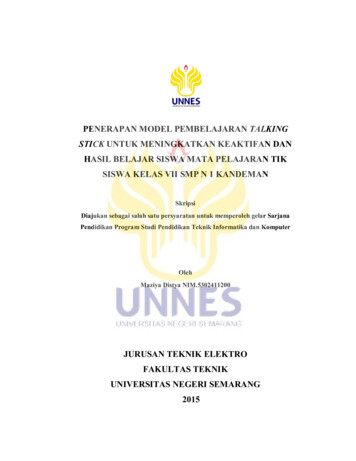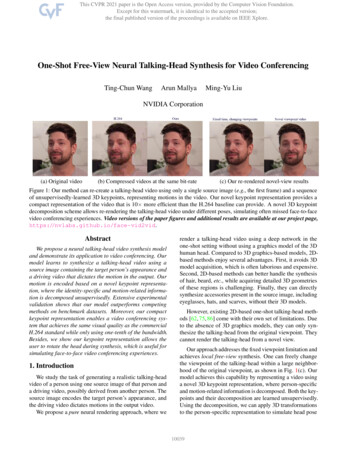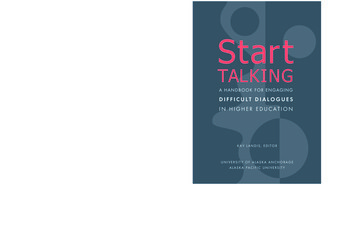
Transcription
So, why am I talking about Btrfs? I've been using linux and its different filesystems since 1993I've have been using ext2/ext3/ext4 for 20 years.But I worked at Network Appliance in 1997, and I've grownhooked to snapshots. LVM snapshots never worked well on linux, and have greatperformance problems (I've seen I/O speed go down to 2MB/s). I also like using partitions to separate my filesystems, but LVMpartitions are not ideal and add the overhead of using LVM. I wanted this badly enough that I switched my laptop to btrfs 2years ago, and more machines since then.
Why Should You Consider Btrfs? Copy On Write (COW) allows for atomic transactions withouta separate journal Snapshots are built in the filesystem and cost littleperformance, especially compared to LVM. cp –reflink always copies within and between subvolumeswithout duplicating data (ZFS doesn't support this). Metadata is redundant and checksummed and data ischecksummed too (ext4 only has experimental metadatachecksums http://goo.gl/tmyAS3 ). If you use docker, Btrfs is your best underlying filesystem.
Why Should You Consider Btrfs? (2) Raid 0, 1, 5, and 6 are also built in the filesystemYou won't need multiple partitions or LVM Logical Volumesanymore, so you'll never have to resize a partition. File compression is also built in (lzo or zlib)Online background filesystem scrub (partial fsck)Block level filesystem diff backups (btrfs send/receive insteadof slow rsync) Btrfs-convert can convert ext3 to btrfs while keeping yourdata, but it can fail, so backups are recommended and anormal copy is better.
But why not use ZFS? ZFS is more mature than Btrfs.ZFS offers almost all the features that Btrfs offers, and a fewmore. But it was licensed by SUN to be incompatible with the linuxkernel license (you can put both together yourself, but youcannot redistribute a kernel with both). ZFS is very memory hungry, it's recommended to have 16GBof RAM and give 8GB or more to ZFS (it doesn't play wellwith the linux memory filesystem, so it uses its own memorythat can't be shared).
ZFS licensing Oracle bought Sun which had licensing right and patents tothe original ZFS code Therefore Oracle could relicense the original code fromCDDL to GPL-2 and replace/get rights to the patchessubmitted to open Solaris. It would seem a like a lot less work than writing a newfilesystem from scratch
Were patents a problem with ZFS? Netapp sued Sun saying ZFS infringed 7 WAFL patentshttp://goo.gl/PlzByI That said Sun attacked Netapp first http://goo.gl/L5gyX5
Were patents a problem with ZFS? Apple was going to use ZFS and later dropped the ideahttp://goo.gl/C5b8M5 Around the same time Oracle starts writing BtrfsChris Mason hints around 2008 that Btrfs has newer designelements than ZFS (and WAFL), and isn't known to violateany patents http://goo.gl/Rfzi5D http://goo.gl/qntsNq Netapp and Oracle agreed to end the suit privatelyhttp://en.swpat.org/wiki/NetApp's filesystem patents Oracle may have stopped further work on ZFS as a result.Or it could be another reason entirely.
Oracle's position on btrfs and ZFS Oracle's official position isOracle began btrfs development years before the Sun acquisition and we currentlyhave no interest in an “official” port of ZFS from Solaris into Linux which wouldrequire a relicensing effort. We’d rather focus on improving btrfs which wasdeveloped from scratch as a mainline kernel (GPLv2) next-generation filesystem.Oracle has several developers dedicated to ongoing btrfs development, and wesupport btrfs on Oracle Linux for production purposes. http://goo.gl/3JVHQe says:"According to Coekaerts, porting ZFS to Linux involves a non-optimal approach thatis not native. As such, there is likely not a need to attempt to bring ZFS to Linuxsince Btrfs is now around to fit the bill. "
Be wary of ZFS for production use You can use ZFS and patch it against kernels on your own, but the codeneeds to be maintained out of tree and patched forever. Vmware workstation mostly died and was replaced by virtualbox becausethe vmware drivers never worked with newer kernels, and it stoppedworking when you upgraded. Due to the CDDL being incompatible with GPLv2, a linux vendor orhardware vendor will never be able to ship a linux distribution or hardwaredevice using ZFS As a result, you shouldn't plan on using ZFS for any product that youmight ever want to ship one day. It is only safe to use ZFS for internal use of something that will never shipto others.
Btrfs: Wait, is it stable/safe yet? Oracle supports Btrfs in its commercial distributionBasic Btrfs is mostly stable: Snapshots, raid 0, raid 1.It typically doesn't just corrupt itself in recent kernels ( 3.1x), but itcould. Always have backups. It changes quickly though, so use recent kernels if you can, butconsider staying a kernel or two behind for stability. It can get out of balance and require manual re-balancingAuto defrag has performance problems with journal and virtual diskimage files Btrfs send/receive mostly works reliably as of 3.14.xRaid 5 and 6 are still experimental as of 3.16
What's not there yet? Fsck.btrfs aka btrfsck or btrfs check –repair is incompleteBut thankfully it's mostly not needed and there are other recoveryoptions File encryption is not supported yet (can be done via dm-crypt)Dedup is experimental via a userland tool, and online real timededup hasn't been written yet More testing and polish, as well as brave users like you :)
Who contributes to Btrfs?Incomplete list: rs FacebookFujitsuFusion-IOIntelLinux FoundationNetgearOracleRed HatStratoSuse / Novell Your company name here :)
Who uses Btrfs in production? https://btrfs.wiki.kernel.org/index.php/Production Usershttp://www.phoronix.com/scan.php?page news item&px MTY0NDkIt looks like in 2014 might finally be the year we see more real-worlddeployments of Btrfs in place of EXT4 or XFS. This year openSUSE 13.2is switching to Btrfs by default for new installations as the first tier-oneLinux distribution relying upon the next-generation open-source filesystem. http://lwn.net/Articles/577728/ (Jon Corbet's predictions)Btrfs will start seeing wider production use in 2014, finally, though userswill learn to pick and choose between the various available features.
Ok, great, so how do I use BTRFS?We will look at best practices, namely: When things go wrong: filesystem recoveryBtrfs scrub/log parsingDmcrypt, Raid, and CompressionPool directoryHistorical Snapshots and backupsWhat to do with out of space problems (real and not real)Btrfs send/receiveTips and tricks: cp –reflink, defragmenting, nocow with chattrHow btrfs raid 1 works. Raid 5/6
Filesystem rfsck explains: btrfs scrub to detect issues on live filesystems (but it is not a fullonline fsck). look at btrfs detected errors in syslogmount -o ro,recovery to mount a filesystem with issuesbtrfs-zero-log might help in specific cases.btrfs restore will help you copy data off a broken btrfs /Restore btrfs check --repair, aka btrfsck is your last option if the ones abovehave not worked.
Btrfs scrub Run scrub nightly or weekly on all btrfs filesystemsEven on a non RAID filesystem, btrfs usually has two copies ofmetadata which are both checksummed (-m dup for mkfs.btrfs).Data blocks are not duplicated unless you have RAID1 or higher,but they are checksummedScrub will therefore know if your metadata is corrupted andtypically correct it on its ownIt can also tell you if your data blocks got corrupted, auto fix them ifRAID allows, or report them to you in syslog otherwise.Knowing that your data is corrupted is valuable, since you knowyou can restore from backup (many filesystems do not give youthis information).More repair strategies and watching btrfs-scrub logs on my blog:http://goo.gl/knHpM6
Btrfs scrub issueHow to fix a scrub that stopped half way:gargamel: # btrfs scrub start d /dev/mapper/dshelf1ERROR: scrub is already running.To cancel use 'btrfs scrub cancel /dev/mapper/dshelf1'.gargamel: # btrfs scrub status /dev/mapper/dshelf1scrub status for 6358304a 2234 4243 b02d 4944c9af47d7scrub started at Tue Apr 8 08:36:18 2014, running for 46347 secondstotal bytes scrubbed: 5.70TiB with 0 errorsgargamel: # btrfs scrub cancel /dev/mapper/dshelf1ERROR: scrub cancel failed on /dev/mapper/dshelf1: not runninggargamel: # perl pi e 's/finished:0/finished:1/' /var/lib/btrfs/* FIXgargamel: # btrfs scrub status /dev/mapper/dshelf1scrub status for 6358304a 2234 4243 b02d 4944c9af47d7scrub started at Tue Apr 8 08:36:18 2014 and finished after 46347secondstotal bytes scrubbed: 5.70TiB with 0 errorsgargamel: # btrfs scrub start d /dev/mapper/dshelf1scrub started on /dev/mapper/dshelf1, fsid 6358304a 2234 4243 b02d 4944c9af47d7 (pid 24196)
Dmcrypt, dm-raid, and btrfs, which one comes first? If you use software raid, it's less work to setupdecryption of a single md raid5 device than X underlyingdevicesWith dmcrypt on top of dm-raid5, you only need to cryptn-1 disks of data.Recent kernels thread dmcrypt well enough acrossCPUsSo, you have btrfs on top of dmcrypt on top of dm-raid.But if you use btrfs built in raid 0, 1, 5, 6, you have tosetup a decryption of each device at boot.
Multi-device dmcrypt and btrfs Mounting btrfs from dmcrypted devices is more workFirst you need to decrypt all devicesRun btrfs scan and then you can run btrfs mountYou either use mount LABEL or mount/dev/mapper/cryptdev1 (give any device and theothers get auto-detected):mount -v -t btrfs -o compress zlib,noatime LABEL LABEL /mnt/btrfs poolmount -v -t btrfs -o compress lzo,noatime /dev/mapper/cryptdev1 /mnt/btrfs poolYou can use my script to automate this:start-btrfs-dmcrypt available at http://goo.gl/0FI94W
Btrfs pool, subvolumes With btrfs, you don't need to create partitions anymoreYou typically create a storage poolIn which you create subvolumesSubvolumes can get quotas and get snapshottedThink of subvolumes as resizeable partitions that canshare data blocksmount -o compress lzo,noatime LABEL btrfs pool /mnt/btrfs poolbtrfs subvolume create /mnt/btrfs pool/rootbtrfs subvolume create /mnt/btrfs pool/usrMount with:boot: root /dev/sda1 rootflags subvol rootmount -o subvol usr /dev/sda1 /usror mount -o bind /mnt/btrfs pool/usr /usr
Btrfs subvolume snapshots The most appealing feature in btrfs is snapshots.Snapshots work on subvolumesYou can snapshot a snapshotYou can make a read only snapshot, or a read-writesnapshot of a read-only snapshotlegolas:/mnt/btrfs pool1# btrfs subvolume create testCreate subvolume './test'legolas:/mnt/btrfs pool1# touch test/foolegolas:/mnt/btrfs pool1# btrfs subvolume snapshot test test snapCreate a snapshot of 'test' in './test snap'legolas:/mnt/btrfs pool1# touch test snap/barlegolas:/mnt/btrfs pool1# rm test/foolegolas:/mnt/btrfs pool1# ls test snap/bar foo
Btrfs subvolume snapshotslegolas:/mnt/btrfs pool1# btrfs subvolume show test/mnt/btrfs pool1/testName:testuuid:2cd10c93 31a3 ed42 bac9 84f6f86215b3Parent uuid: Creation time:2014 05 03 18:41:15Object ID:25576Generation (Gen):406949Gen at creation: 406947Snapshot(s):Test snap legolas:/mnt/btrfs pool1# btrfs subvolume show test snap//mnt/btrfs pool1/test snapName:test snapuuid:9529d4e3 1c64 ec4e 89a0 7fa010a115feParent uuid:2cd10c93 31a3 ed42 bac9 84f6f86215b3 Creation time:2014 05 03 18:41:29Object ID:25577Generation (Gen):406949Gen at creation: 406948Snapshot(s):
Snapshots are not real backups
This is probably the wrong backup strategy :)
Historical snapshots to go back in time You can use the script I wrote that will look at any btrfspool, find all the subvolumes and snapshot them(optionally) by hour/day/week.See my blog post at http://goo.gl/On7CZRdrwxr xr xdrwxr xr xdrwxr xr xdrwxr xr xdrwxr xr xdrwxr xr xdrwxr xr xdrwxr xr xdrwxr xr xdrwxr xr xdrwxr xr xdrwxr xr xdrwxr xr 3810:3810:3810:3821:4010:3810:3810:38rootroot daily 20140316 00:05:01root daily 20140318 00:05:01root daily 20140319 00:05:01root daily 20140320 00:05:00root hourly 20140316 22:33:00root hourly 20140318 00:05:01root hourly 20140319 00:05:01root hourly 20140320 00:05:00root weekly 20140223 00:06:01root weekly 20140302 00:06:01root weekly 20140309 00:06:01root weekly 20140316 00:06:01
Atime, relatime vs snapshots Atime forces the system to write to each inode every timeyou update a fileRelatime (now the default with recent kernels) does this moreintelligently and less often, but at least once a day, that's toomuch still.Unfortunately if you use snapshots, this creates a lot ofwrites and differing data each time you access files andcause an atime updateAs a result, if you use snapshots, noatime is stronglyrecommended.
Help, I really ran out of spacegandalfthegreat: # btrfs fi showLabel: 'btrfs pool1' uuid: 873d526c e911 4234 af1b 239889cd143dTotal devices 1 FS bytes used 214.44GBdevid1 size 231.02GB used 231.02GB path /dev/dm 0 Btrfs fi show will tell you if your device is really full.Here the device is full (needs a rebalance) and the FS almost full.First thing to do if you have historical snapshots is to delete theoldest onesIf you just copied 100G without –reflink and deleted the copy, youmay have to delete all historical snapshotsIf you delete snapshots, it may take minutes for btrfs to dogarbage collection and free space to come back.Unfortunately it's currently difficult to know how much space eachsnapshot takes (since the space is shared and deleting a singlesnapshot may not reclaim it)
Help, btrfs says I ran out of space, but I didn't. Currently btrfs has issues where it needs to have itschunks rewritten to rebalance space (btrfs filesystemdf /mnt and btrfs fi show both agree there is free space)Counting free space is tricky, seehttps://btrfs.wiki.kernel.org/index.php/FAQ#Raw disk usageMore generally I've written a page explaining how todeal with filesystems are full (but usually aren't really):http://goo.gl/NU42P0
Btrfs built in compression mount -o compress lzo is fast and best for ssdmount -o compress zlib compresses better but isslower.Compression is a mount option that affects files writtenafter the mountIf you change your mind after the fact, you can use btrfsbalance to rewrite data blocks which recompressesthem in the process.
Defragmentation and NOCOW If you have a virtual disk image, or a database file that getswritten randomly in the middle, Copy On Write is going tocause many fragments since each write is a new fragment.My virtualbox image grew 100,000 fragments quickly.You can turn off COW for specific files and directories withchattr C /path (new files will inherit this).btrfs filesystem defragment vbox.vdi could take hourscp –reflink never vbox.vdi vbox.vdi.new; rm vbox.vdiis much fasterbtrfs filesystem defragment can be used to recompress fileswhile defragmenting, but can be very slow if you havesnapshots.
Block deduplication and cp --reflink After the fact block deduplication is currentlyexperimental: https://github.com/g2p/bedupInline deduplication is not ready yet as of 3.14, but stillplanned.cp –reflink /mnt/src /mnt/dest duplicates a file whilereusing the same data blocks, but allows you to modifydest (can't do this with hardlinks)cp –reflink /mnt/btrfs pool/subvol1/src/mnt/btrfs pool/subvol2/dest lets you copy/move a fileacross subvolumes without duplicating data blocks.
Btrfs send/receive This is a killer app for btrfs: rsync is inefficient and slow whenyou have many files to copy.This is where btrfs send/receive come in.btrfs send vol ssh host “btrfs receive /mnt/pool”Later copies only send a diff between snapshots, this diff iscomputed instantly when rsync could take an hour or more togenerate a list of diffs:btrfs send p vol new ro vol old ro btrfs receive/mnt/poolIt's a bit hard to setup, so I wrote a script you can use:http://goo.gl/OLkbjT
Finale: btrfs send/receive to replicate server images Last year I gave a talk on how google does live serverupgrades by doing file level updates http://goo.gl/CxedKWe use a custom rsync like system that was tricky to writeand generates a lot of I/OInstead, you can use btrfs send/receive to replicate a goldenimage in a subvolume to all your serversLocal changes are symlinked to a local FS or bind mountedon a file by file basis.Once the new subvolume has the new image, you can rebootto it and/or use kexec for a faster reboot cycle.btrfs-diff shows most files changed, use this to sync changeswith cp –reflink instead of reboot http://goo.gl/fkLxAuImprove btrfs send/receive to only show files changed.
Backing up my laptop SSD to internal HD hourly SSDs can die suddenly with no warning (3 times for me)Back them up at least daily, or even hourlyRsync backups are slowPerfect use case for btrfs send/receive for quickincremental backupsDestination backup is read only snapshot, but my scriptmakes a 2nd R/W snapshot with a symlink pointing to itThat way if my SSD entirely dies, I can still boot frommy backup HD and recovery instantly (but OMG, harddrives are slow).Script that does all the work for you is here: http://goo.gl/OLkbjT
Backup your laptop on itself and boot the backups I then have historical backups on both my SSD and HD, andI can boot from my HD if my SSD fails while I'm on a trip(happened twice already with Crucial and OCZ) or if my btrfsfilesystem crashes and can't boot.Make sure you can boot the 2nd drive whether it shows up asthe first drive or second drive in the bios.Another option for your laptop if you don't need btrfssnapshots for your root filesystem, consider putting that onext4 or having 2 copies you can boot from like I do (btrfsfailures can still lead to a root filesystem that can't mount,making your computer sad).You can finally push backups of your laptop from hotelwireless since they're smaller and faster with btrfs send
Backup your backups, and historical backups
Historical backups with btrfs: snapshots rsynca) Create a subvolume: backup- DATEb) Rsync/copy the data to itc) snapshot of backup- DATE to backup- NEWDATEd) Rsync filesystem to backup- NEWDATEe) RepeatThis is easy to setup A bit of work to do after the fact with existing backupsYou cannot hardlink files between snapshots to save space(but you can use cp –reflink).A bit complicated to copy all these snapshots to a secondaryserver while keeping the snapshot relationship.
Historical backups with btrfs: cp -a --link rsynca) Create a directory backup- DATEb) Rsync/copy the data to itc) cp -a --link backup- DATE backup- NEWDATEd) Rsync filesystem to backup- NEWDATEe) Repeat It's not as efficient as cp –reflink but you can see the linkrelationship between files and keep that when copying toanother filesystemRsync on top of a copied file breaks the hardlink.Older versions of btrfs only allow a limited amount ofhardlinks to a single inode.
Historical backups with btrfs: cp --reflink rsynca) Create a directory backup- DATEb) Rsync/copy the data to itc) cp -a --reflink backup- DATE backup- NEWDATEd) Rsync filesystem to backup- NEWDATEe) RepeatThis may work better than snapshots because: You can use hardlinks between backup directories to dedupidentical files: http://code.google.com/p/hardlinkpy/Rsync on top of a copied file only modifies changed blocksHowever, unix tools can't keep track of this relationshipBtrfs send/receive is the only way to keep this.
Btrfs mixed type filesystems mkfs.btrfs -m raid0 -d raid0 /dev/sda1 /dev/sdb1 non redundant faster filesystemmkfs.btrfs -m raid1 -d raid0 /dev/sda1 /dev/sdb1 metadata is redundant but data is still stripped and nonrecoverable is a drive is lost (files bigger than 16MB)mkfs.btrfs -m raid1 -d single /dev/sda1 /dev/sdb1 data for each file will usually be on a single drive andrecoverable (up to 1GB).mkfs.btrfs -m raid1 -d raid1 /dev/sda1 /dev/sdb1 data is fully redundant and stored on 2 drivesmkfs.btrfs -m raid1 -d raid5 /dev/sda1 /dev/sdb1 /dev/sdc1 medata is only stored on 2 drives, so not more redundantand slower than -m raid5 -d raid5.
Raid 1 vs Raid 5 or 6 Btrfs lets you convert from a single drive to Raid 1, or Raid 5/6on the fly (you need to rebalance after the change)Raid 1 only copies each piece of data twice, regardless of howmany drives you haveRaid 5, 6 are experimental still. Recovery doesn't work insome cases (code missing), and scrub cannot deal withrebuilding bad blocks yet (as of 3.16).However, you can shrink (remove a drive) while running: thiscauses a rebalance to remove data from the drive.Adding a drive is instant and you can ask btrfs to rebalanceexisting files on all drives (this takes much longer).I wrote a lot more about raid5 status here: http://goo.gl/OLkbjT
Now is time for you to evaluate Btrfs. If you pick the right btrfs release/kernel (you can let Oracle orSuse do this for you), you can look at Btrfs for productionuse.Btrfs send/receive is mostly production ready and you canlook at it today.Raid 5/6 still needs work, but is so much faster that it is worthyour time to contribute code to it.Bedup (block dedup) also needs contributors, please help ifit's interesting to you.In a nutshell, while Btrfs is still experimental, it is usable forits core features, even if backups are recommended.2014 is the year for you to evaluate it.If you can contribute to it like Fujitsu does, thank you.
Why Should You Consider Btrfs? (2) Raid 0, 1, 5, and 6 are also built in the filesystem You won't need multiple partitions or LVM Logical Volumes anymore, so you'll never have to resize a partition. File compression is also built in (lzo or zlib) Online background filesystem scrub (partial fsck) Block level filesystem diff backups (btrfs send/receive instead











![[Page 1 – front cover] [Show cover CLEAN GET- AWAY 978-1 .](/img/13/9781984892973-6648.jpg)